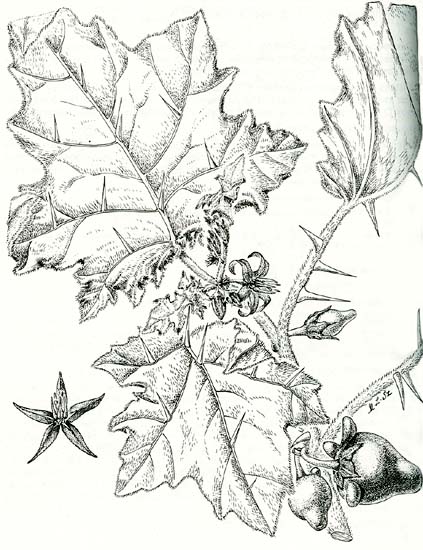 Line drawing by M. Szent Ivany, J. Adelaide Bot. Gard. 4 (1981) 104, fig. 30. |
 Image by Juni from Wikipedia |

Synonymy
Solanum mammosum L., Sp. Pl. 1: 187 (1753)
T: Habitat in Virginia, Barbados; Lectotype = "Solanum Barbadense spinosum, foliis villosis, fructu aureo rotundiore, Pyri parvi inversi forma et magnitudine" in Plukenet, Phytographia, t. 226, f. 1, 1692. Typotype: Herb. Sloane 98: 59 (BM-SL).
Knapp & Jarvis (Bot. J. Linn. Soc. 104 : 344, f. 13 (1990)) identified LINN 248.32, cited by Symon 1981as the type of this species, as a post-1753 collection by Browne and hence not part of the type gathering.
Description
Annual or short-lived perennial shrub to 2 m, green, hirsute with simple and occasionally stellate eglandular hairs; prickles 10-15 mm long, straw-coloured, usually straight, scattered on stems and leaves.
Leaves broadly ovate to orbicular, the lamina up to 15 cm long and wide, but usually smaller, concolorous, 5-7-lobed; petiole 6-10 cm long.
Flowers 1-4 in sub-sessile cyme; pedicels 8-10 mm long. Calyx 5-6 mm long; lobes subulate-acuminate, 3-4 mm long. Corolla stellate, deeply incised, 30-40 mm diam., pale purple-blue. Anthers 7-8 mm long.
Berry pear-shaped with basal outgrowths, 30-60 mm long, yellow or orange, flesh white. Seeds purple-red, punctate. n=11, 12.
Distribution and ecology
Occasionally grown as an ornamental in Australia. Not known to be naturalised but has the potential to become so in tropical and subtropical regions of Australia.
Native of South America.
Common name
Nipple Fruit
Relationships
S. mammosum is part of the group of subgen. Leptostemonum that bears its name (Whalen 1984).
Notes
Occasionally cultivated for its bizarre fruits which it has been surmised have been selected from wild types with globular fruit.
An illustration of the species can be found in Welman, W.G. (2003). The genus Solanum (Solanaceae) in southern Africa: subgenus Leptostemonum, the introduced sections Acanthophora and Torva. Bothalia 33: 9, fig. 5.
From the web
Considerable information, images and links for this species can be found on the Solanaceae Source site.
Further information about this species can be accessed through the Plants Profile site of the US Department of Agriculture and the Pacific Island Ecosystems at Risk (PIER) site.
Images of the fruit which are grown for decorative purposes can be seen on the Digital Flora of Texas page and numerous other sites through Google images. Flowers can be seen at http://jetzt.sueddeutsche.de/texte/anzeigen/466724
Links to images of S. mammosum (photos and herbarium specimens) can be seen on the Radboud University, Nijmegen (Netherlands) site.